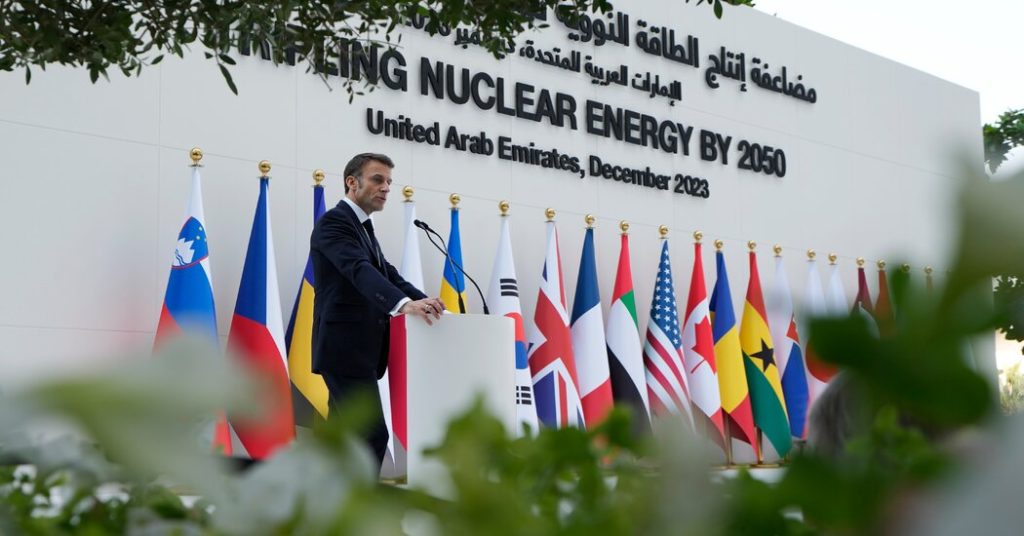At COP28, More Than 20 Nations Pledge to Triple Nuclear Capacity
3 min read
The United States and 21 other countries pledged on Saturday at the United Nations climate summit in Dubai to triple nuclear energy capacity by 2050, saying the revival of nuclear power was critical for cutting carbon emissions to near zero in the coming decades.
Proponents of nuclear energy, which supplies 18 percent of electricity in the United States, say it is a clean, safe and reliable complement to wind and solar energy. But a significant hurdle is funding.
Last month, a developer of small nuclear reactors in Idaho said it was canceling a project that had been expected to be part of a new wave of power plants. The cost of building the reactors had risen to $9.3 billion from $5.3 billion because of increasing interest rates and inflation.
Britain, Canada, France, Ghana, South Korea, Sweden and the United Arab Emirates were among the 22 countries that signed the declaration to triple capacity from 2020 levels.
Tripling nuclear energy capacity by 2050, which would also help Europe reduce its dependence on Russia oil and gas, would require significant investment. In advanced economies, which have nearly 70 percent of global nuclear capacity, investment has stalled as construction costs have soared, projects have run over budget and faced delays. On top of cost, another hurdle to expanding nuclear capacity is that plants are slower to build than many other forms of power.
Addressing the issue of financing, John Kerry, President Biden’s climate envoy, said that there were “trillions of dollars” available that could be used for investment in nuclear. “We are not making the argument to anybody that this is absolutely going to be the sweeping alternative to every other energy source — no, that’s not what brings us here,” he said. But, he added, the science has shown that “you can’t get to net-zero 2050 without some nuclear.”
Nuclear power does not emit carbon, and an International Energy Agency report last year said that nuclear was crucial to helping to reduce carbon emissions in line with the Paris Agreement goals outlined in 2015.
President Emmanuel Macron of France said nuclear energy, including small modular reactors, was an “indispensable solution” to efforts to curb climate change. France, Europe’s biggest producer of nuclear power, gets about 70 percent of its own electricity from nuclear stations.
Mr. Macron and other leaders, including Prime Minister Ulf Kristersson of Sweden, called on the World Bank and international financial institutions to help finance nuclear projects. Mr. Kristersson said that governments must “assume a role in sharing the financial risks to strengthen the conditions and provide additional incentives for investments in nuclear energy.”
While world leaders on Saturday called nuclear the most effective alternative to fossil fuels, some climate activists said nuclear energy was not a panacea.
David Tong, a researcher at Oil Change International, said the pledge was divorced from the reality of nuclear energy — that it was too costly and too slow. “It’s a self-serving political pledge that doesn’t reflect the role that nuclear is likely to play in the energy transition, which is menial,” he said. “There is very small growth in nuclear — certainly nothing like tripling.”
He said he rejected the stance that there was no pathway to limit global warming to 1.5 degrees Celsius above preindustrial levels, a goal set in the Paris Agreement to avoid the worst effects of global warming, without nuclear. Masayoshi Iyoda, an activist from Japan with 350.org, an international climate action campaign, cited the nuclear disaster at Fukushima in 2011 and said that nuclear power was a dangerous distraction from decarbonization goals. “It is simply too costly, too risky, too undemocratic, and too time-consuming,” he said in a statement.
“We already have cheaper, safer, democratic, and faster solutions to the climate crisis, and they are renewable energy and energy efficiency,” Mr. Iyoda said.
All but four of the 31 reactors that have begun construction since 2017 were designed by Russia or China, with China poised to become the leading nuclear power producer by 2030, the International Energy Agency said. This year, Germany shut its last three nuclear plants.
Nuclear capacity rose in the 1980s, particularly in Europe and North America, but dropped sharply over the subsequent years after accidents at Three Mile Island in Pennsylvania in 1979 and Chernobyl in 1986. New technology and tighter regulations have been put in place since then.
Americans are conflicted about nuclear power, but a growing number favor expansion compared with a few years ago, according to a Pew Research Center study published in August.





